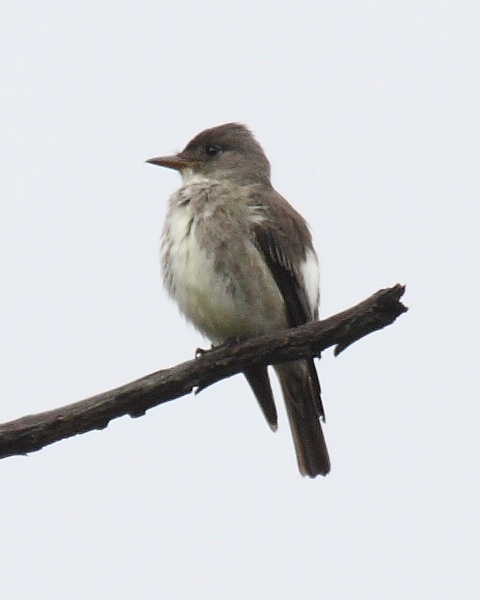On Sunday afternoon I saw an olive-sided flycatcher above the Sand Dunes Trail at Oak Openings Preserve, Swanton, Ohio. I mention these specifics because he was only the second olive-sided flycatcher I’ve ever seen. The first was 11 years ago at Raccoon Creek State Park on May 18, 2003.
Olive-sided flycatchers were always uncommon and now are increasingly rare. In the past 40 years they’ve declined 3.3% per year, especially in western North America. Where there used to be 100 individuals there are only 27 now. They used to nest in Pennsylvania but no more.
Though he isn’t a flashy color he’s the peregrine falcon of flycatchers. Perched high on a dead snag he scans the air for large flying insects, dives to catch them, and chases them down if they try to escape. This bird is fast! I watched him chase down bees or wasps, return to the perch and swallow each catch in a single gulp. He rarely missed. Then, just like a bird of prey, he ejected a pellet.
Olive-sided flycatchers breed at coniferous and boreal forest edges in the western U.S. and Canada and spend the winter in northwestern South America. They happen to prefer burned or logged areas because the openings make for better flycatching. The bird I found was in a location that had burned several years ago.
Pesticides, loss of bees and wasps, and habitat loss in North and South America have all contributed to the olive-sided flycatcher’s decline. A reintroduction program like the one that restored the peregrine falcon can’t save this bird. Instead we have to cooperate to preserve large tracts of his habitat. Unfortunately, human cooperation on this scale is notoriously difficult to achieve.
This was my second look at an olive-sided flycatcher. Will it be my last?
(photo by Dominic Sherony, Creative Commons license on Wikimedia Commons. Click on the image to see the original.)
